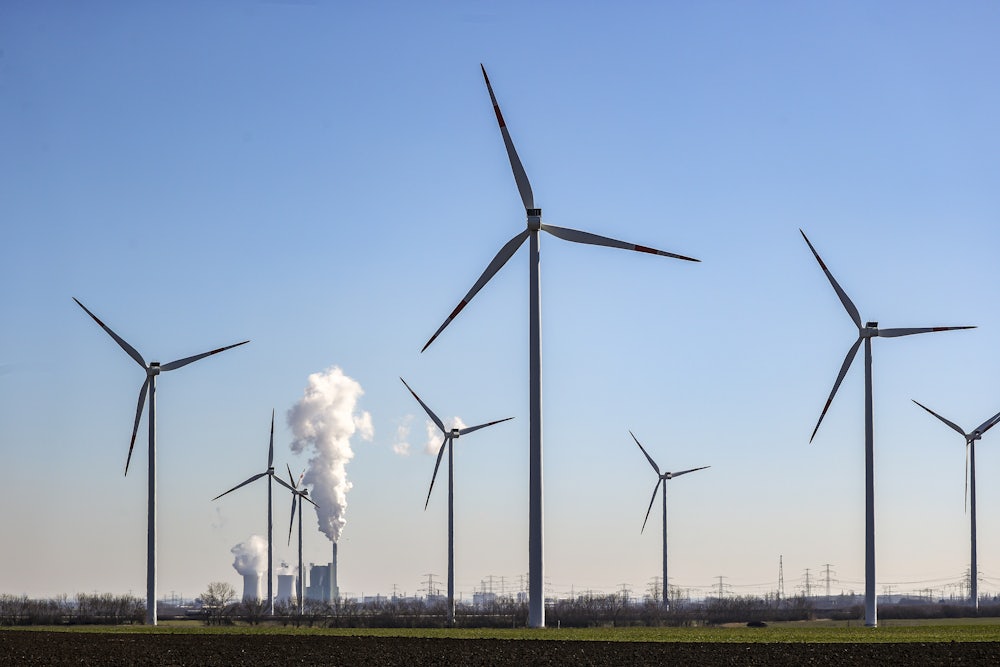As Russia’s unprovoked invasion of Ukraine continues, American oil and gas producers are hoping the European market will pivot toward them to replace Russian gas. But some in Europe, and specifically Germany, are eyeing a different path: rapidly accelerating toward 100 percent renewable energy. Whether Europe and the world can successfully meet Paris Agreement targets may depend partly on which type of infrastructure gets locked in as the international community scrambles to replace Russian fuel.
Russia supplies around 47 percent of Germany’s coal and at least 38 percent of its gas, according to published data (Robert Habeck, Germany’s economy and climate minister, cited a much higher figure—55 percent—in February). Shortly following Vladimir Putin’s announcement that Russia was invading Ukraine, however, German Chancellor Olaf Scholtz halted certification on the controversial Nord Stream 2 pipeline, which would have carried more gas from Russia to Germany’s northern coast. Now both Germany and the EU are figuring out how to proceed with the elusive dream of renewable energy independence.
Last week Habeck announced the government’s intention to expedite implementation of amendments to the Renewable Energy Sources Act, or EEG, providing a hard deadline of July 1, 2022. The EEG would double Germany’s onshore wind capacity from 55 to 110 gigawatts, while also increasing the offshore wind capacity to 30 GW. To help put this into perspective, the U.S. Department of Energy states that 364 utility-scale wind turbines would be necessary to generate just 1 GW of energy. This investment in wind power is truly enormous. (The Biden administration also has a goal of getting to 30 GW offshore by 2030, but it’s worth remembering that the U.S. government budget is several times the size of Germany’s.) On the solar end of the spectrum, the EEG also aims to triple solar energy capacity to 200 GW by 2028 from the current 5 GW potential. The EEG will also suspend anticipated cuts to new solar panels on roofs, thus maintaining the economic incentive for private homeowners to invest in solar energy.
In addition to expediting the implementation of the EEG, the German government now plans to achieve 100 percent renewable energy by 2035 (previously the goal was a vague “well before 2040, with 65 percent renewable energy generation by 2030”), with 80 percent of electricity coming from renewables by 2030.
The EU, meanwhile, introduced a proposal on Tuesday called RePowerEU to reduce Russian gas dependence. The proposal includes a commitment to diversify energy sources with the goal of complete divestment from Russia by 2030. Similar to Germany’s EEG, the drafted EU legislation prioritizes increasing capacity for wind and solar power while also creating an opportunity for biomethane, “recommending a bloc-wide production of 35 billion cubic meters by 2030,” along with 25–50 billion cubic meters of renewable hydrogen power.
For both Germany and the EU, however, the road to renewable energy independence is plagued with roadblocks. One major hurdle is the need to heat homes now and in the immediate future, a task that cannot be accomplished until the new solar and wind power stations are fully functioning. In the meantime, Germany has greenlit the development of two new liquefied natural gas terminals and announced a recent 1.5 billion euro order for non-Russian LNG. While also acquired by hydraulic fracturing, LNG differs from its natural gas counterpart by requiring energy intensive liquefaction, in which the natural gas is cooled to liquid form and stored in cryogenic tanks. These additional procedures make the overall ecological footprint of LNG bigger than for pipeline gas.
“The real problem,” climate economist Gernot Wagner of New York University told me, is that adding LNG capacity now could sabotage renewable energy goals down the line. “Every time you have one of these emergency measures, somebody somewhere is going to start lobbying to keep those LNG terminals in place.” And the timeline of construction certainly signals a long-term reliance on LNG. The earliest of the two proposed terminals won’t be completed until 2026, which means that new LNG investments won’t solve the immediate problem of reliance on Russian gas any more than new wind turbines can.
One of the new requirements included in the EU’s proposed legislation is for member states to have an average level of gas-storage filling of at least 90 percent by October 1. (In theory, this would make it easier for the EU to weather a temporary crisis—for example, if Russia were to cut off gas flows to Europe during winter.) It is clear that LNG will continue to be viewed as the necessary bridge between fossil fuels and renewable energy. But the new uncertainty regarding gas shortages is also leading some policymakers to reconsider phasing out coal.
“There are no taboos in this situation,” said Frans Timmermans, the EU’s Green Deal chief, regarding coal to BBC Radio 4 on March 3. The original plan for many of the EU’s member states was to use LNG as the bridge between coal and renewable energy, but with gas no longer a certain option, some countries may extend the utilization of coal as the primary source of energy, making the jump to renewable energy without any intermediary steps. Timmermans believes this new plan could “still be within the parameters [the EU] set for climate policy.” And according to Politico, both Italy and Poland are “already eyeing a pivot back to coal.”
Legislation in both Germany and the EU is ongoing, with no permanent decisions yet made to combat the Russian invasion and compensate for a lack of Russian gas. However, other institutions and individual experts are releasing outlines of how Europe could change the face of energy production in the twenty-first century.
The Wuppertal Institute in Germany recently released a study, commissioned by Greenpeace, that presents a mixed policy approach of “demanding and promoting” renewable energy innovation. Requiring a hefty annual investment of 50 billion euros, the institute’s plan would facilitate a complete phaseout of oil and gas and usher in a long-term return on investment of 11.5 billion euros a year by 2035. The study urges politicians to prioritize renewable energy investing in order to see a reduction of 168 million metric tons of CO2 equivalent per year. The study also details the immediate laws and actions Germany would take to feasibly implement its new, permanent renewable energy infrastructure.
Focusing on America’s contribution to Germany and the EU’s predicament, prominent environmentalist and founder of 350.org Bill McKibben recently shared another idea: electric heat pump manufacturing. In his newsletter The Crucial Years, McKibben suggested President Biden invoke the Defense Production Act to “get American manufacturers to start producing electric heat pumps in quantity” to send across the Atlantic to increase energy efficiency. McKibben reasons that heat pumps, which are able to transfer heat as opposed to converting it, are the obvious next step in cutting down carbon footprints and reducing foreign gas and oil dependency. Additionally, by manufacturing the equipment via the DPA on American soil, companies will have the financial support of government contracts and increase domestic jobs, boosting the economy.
Whether any of these plans are a sure route to energy independence is unknown. But the sheer amount of human energy and capital currently dedicated to weaning Germany and the EU permanently off fossil fuels finally, regardless of the motivating factor, opens a door to possibilities. The stakes have never been higher: While Putin’s war of aggression may have triggered this new legislative frenzy, how policymakers respond in these next few weeks and months will determine whether the goals originally established in the Paris Climate Agreement and COP26 can actually be achieved before it’s too late.










